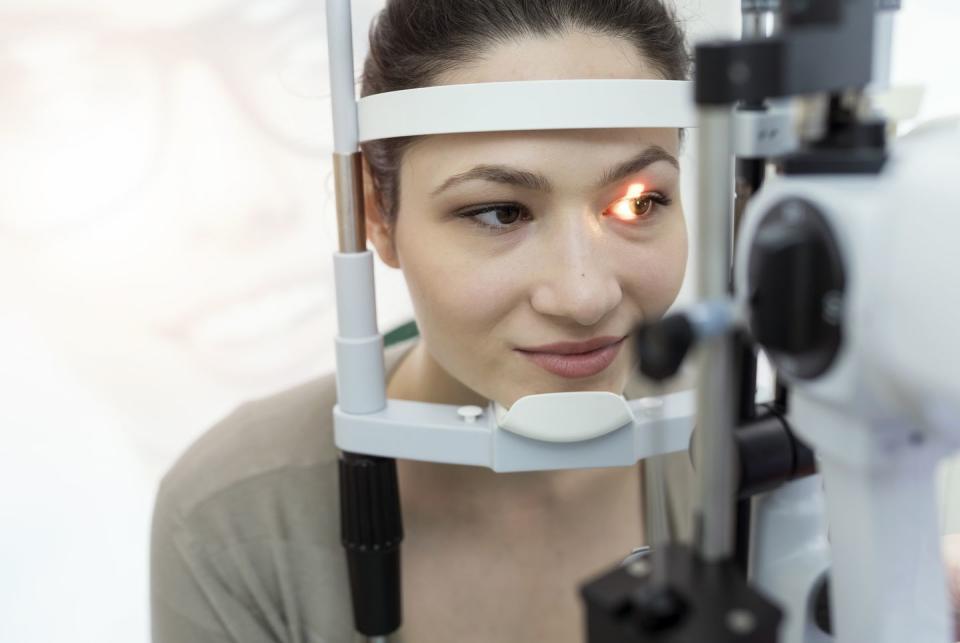7 Things You Need To Know About Cataracts

Ask most people what they know about cataracts and you'll probably hear a combination of the terms "eye problem," "blurry vision," and "older people." That's not surprising because roughly half of all Americans who reach age 80 will have to contend with cataracts, according the National Institutes of Health. However, it is possible to have age-related cataracts starting in your 40s, though they usually don't mess with your vision until you get past 60. And some middle-aged men and women may be unknowingly squinting or straining to see clearly through cataracts, says Stephen Foster, M.D., a clinical professor of ophthalmology at Harvard Medical School and founder of Massachusetts Eye Research & Surgery Institution. So exactly what is a cataract? Here's what most people don't understand about this common eye condition.
1. Cataracts don't form on your eyes.
"That's the most frequent misunderstanding I encounter," says Dr. Foster. By definition, a cataract is a clouding of the eye's lens. Many people assume that a foggy coating has developed on top of the lens, but a cataract actually forms inside the eye. The vision-distorting haze occurs when proteins that comprise the normally crystal-clear lens break down. "You can't feel a cataract, and it could take months or years to progress to a stage where you require surgery to remove it," he says.
2. Getting older isn't the only risk factor for cataracts.
Most cataracts are age-related, but it's possible to develop them thanks to an eye injury or following surgery for another eye issue, such as glaucoma. Radiation and sun exposure also put you at risk; bright sunlight may speed the breakdown of those lens proteins. Meanwhile, some cataracts are congenital and babies are occasionally born with them.
3. Cataracts may affect only one eye.
While "bilateral" cataracts are more common, it's possible for a cataract to develop in just one of your eyes, according to Dr. Foster. "Especially if you've suffered some kind of blow or trauma to one of your eyes, that may result in a cataract developing in one eye but not the other," he explains.
4. Cataracts can distort your vision in different ways.
"I've had cataract patients with 20-20 vision," says Dr. Foster. Some people end up with eyesight that's constantly blurry, but others only have trouble under certain conditions. "I just saw a patient who complained about difficulty seeing when driving at night," he recalls. "His vision was perfect most of the time, but he had a particular type of cataract that causes light scatter."

5. Not everyone who develops a cataract requires surgery.
When your cataract first starts to form, your vision isn't affected much, Dr. Foster explains. "Many people put off surgery for years," he says. And no, there aren't really any risks associated with this procedure procrastination. "I always say that if a cataract affects your quality of life, then we need to make plans to take it out," he says. "Otherwise, we can forget about it until your next appointment."
6. Cataract surgery is super common—and super safe.
If you've reached the point where you need to go under the knife, don't panic: Cataract surgery has a 96% success rate, making it one of the safest procedures in modern medicine, says Dr. Foster. "It involves local anesthetic, a small incision, and no stitches," he says. Your eye surgeon will remove your lens, clean out any accumulated gunk, and insert a new lens implant. "It only takes about 15 minutes," he adds. (Ask your doctor these 5 questions before surgery.) After the procedure, you'll have to wear a protective shield when you sleep or nap, and you won't be able to jog for a couple of weeks. But your vision may be clearer as soon as the day after surgery, and within a month you'll be fully recovered and seeing better than ever, according to Dr. Foster.
7. You can't stop the clock, but you can reduce your risk.
Wearing UV-blocking sunglasses and loading up on antioxidant-rich fruits and veggies can help—as can not smoking, limiting alcohol, and doing your best to avoid developing diabetes.
Support from readers like you helps us do our best work. Go here to subscribe to Prevention and get 12 FREE gifts. And sign up for our FREE newsletter here for daily health, nutrition, and fitness advice.
You Might Also Like

